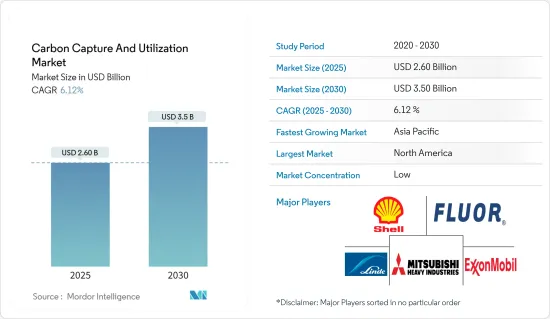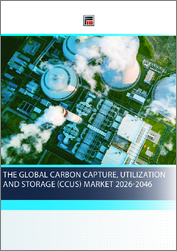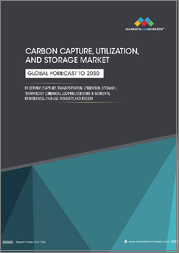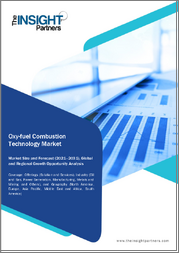
|
시장보고서
상품코드
1636422
세계의 탄소 포집 및 이용(CCU) 시장 : 점유율 분석, 산업 동향 및 통계, 성장 예측(2025-2030년)Carbon Capture And Utilization - Market Share Analysis, Industry Trends & Statistics, Growth Forecasts (2025 - 2030) |
||||||
탄소 포집 및 이용(CCU) 시장 규모는 2025년 26억 달러, 2030년 35억 달러로 예측되며, 예측기간(2025-2030년)중 CAGR은 6.12%에 달할 것으로 예측됩니다.

탄소 포집 및 이용(CCU) 분야는 산업 공정과 대기로부터 배출되는 이산화탄소(CO2)를 회수하고 가치 있는 상품에 재이용하는 것을 중심으로 급속히 발전하고 있습니다. 이러한 기술은 온실가스 배출을 억제하고 기후 변화와 싸우며 동시에 경제적 이익을 창출하는데 있어 매우 중요한 역할을 합니다.
CCU 시장은 기후 변화에 대한 인식 증가, 배출량 감소를 위한 엄격한 정부 규제, 지속가능한 제품에 대한 수요 증가 등 여러 요인들에 의해 견인되고 있습니다. CCU 기술은 화학물질, 연료, 건축재료 등의 가치있는 제품을 생산하면서 CO2 배출량을 줄이는 방법을 제공하여 순환 경제 접근법을 창출합니다.
정부, 산업계, 소비자들이 기후 변화와 싸우는 지속가능한 해결책을 점점 더 우선시함에 따라 CCU 시장은 크게 성장하고 있습니다. CCU 기술의 잠재력을 극대화하고 세계 기후 변화 목표를 달성하기 위해서는 이해관계자간 지속적인 혁신과 협력이 필수적입니다.
탄소 포집 및 이용(CCU) 시장 동향
석유 및 가스 산업이 시장의 주요 최종 사용자
석유 및 가스산업은 특히 화석연료의 생산과 정제에 있어서 이산화탄소(CO2) 배출량이 많기 때문에 탄소 포집 및 이용(CCU) 기술의 중요한 채용기업으로 두드러지고 있습니다.
원래 석유 및 가스 분야에서 선구적으로 개발된 CCUS 기술은 육상 및 해상의 심부지층에 CO2를 격리하는 것입니다. CO2는 보통 석유와 섞이지 않지만, 저류층에 주입함으로써 압력을 높여 생산정으로 석유의 이동을 돕습니다.
CCU 기술은 석유 및 가스 산업에 CO2를 회수할 뿐만 아니라 배출된 CO2를 재사용함으로써 환경에 미치는 영향을 줄여줍니다. 재사용된 CO2는 석유 회수 촉진(EOR), 화학물질 및 연료 생산의 원료로 사용, 건설용 콘크리트의 탄산화 등 다양한 용도로 사용됩니다. CCU 기술을 채택함으로써 석유 및 가스 산업은 이산화탄소 배출량을 줄일 뿐만 아니라 수익원도 확대하여 보다 지속 가능한 에너지 상황을 촉진할 수 있습니다.
북미가 탄소 포집 및 이용(CCU) 시장에서 가장 큰 점유율을 차지
북미는 정부의 강력한 지원, 기술 진보, 확립된 산업 기반 등 몇 가지 요인에 따라 탄소 포집 및 이용(CCU) 시장에서 가장 큰 점유율을 차지하고 있습니다. 이 지역은 CCU 기술 개발 및 도입의 최전선에 있으며 미국과 캐나다는 이러한 기술의 연구 개발 및 개발을 선도하고 있습니다.
특히 미국은 연방 정부의 자금 지원과 장려책에 뒷받침되는 CCU 프로젝트와 이니셔티브를 많이 가지고 있습니다. 석유 및 가스 산업을 포함한 광대한 산업 부문은 CCU 도입의 충분한 기회를 제공합니다. 또한 이산화탄소 배출의 억제와 기후 변화에 대한 노력이 중시되어 북미에서의 CCU기술의 도입이 가속화되고 있습니다.
북미는 기술적 진보, 정부의 유리한 조치, 지속가능한 기후 변화 솔루션의 필요성에 대한 인식이 높아짐에 따라 CCU 시장을 선도하는 태세를 갖추고 있습니다.
탄소 포집 및 이용(CCU) 산업 개요
탄소 포집 및 이용(CCU) 시장은 세분화되어 있으며 많은 기업로 구성되어 있습니다. 탄소 포집 및 이용(CCU) 기업은 시장의 성장과 기술 혁신을 추진하기 위해 다양한 전략을 채택하고 있습니다. 주요 전략 중 하나는 산업 공정과 대기에서 배출되는 이산화탄소(CO2)를 회수하고 이용할 수 있는 비용 효율적이고 확장 가능한 CCU 기술을 개발하는 것입니다. 주요 기업은 Royal Dutch Shell PLC, Fluor Corporation, Mitsubishi Heavy Industries Ltd, Linde PLC, and Exxon Mobil Corporation 등입니다.
기타 혜택:
- 엑셀 형식 시장 예측(ME) 시트
- 3개월간의 애널리스트·지원
목차
제1장 서론
- 조사 상정과 시장 정의
- 조사 범위
제2장 조사 방법
제3장 주요 요약
제4장 시장 역학과 인사이트
- 시장 개요
- 시장 성장 촉진요인
- 환경규제와 기후 변화 목표
- CO2 배출량 감축에 대한 관심 증가
- 시장 성장 억제요인
- 높은 도입 비용
- 한정된 저장 용량
- 시장 기회
- CCUS 기술의 연구개발 노력
- 밸류체인 분석
- 업계의 매력 Porter's Five Forces 분석
- 신규 진입업자의 위협
- 구매자의 협상력
- 공급기업의 협상력
- 대체품의 위협
- 경쟁 기업간 경쟁 관계
- 업계의 기술적 진보에 관한 통찰
- 시장을 형성하는 다양한 규제 동향에 관한 통찰
- 시장에 대한 COVID-19의 영향
제5장 시장 세분화
- 서비스별
- 회수
- 수송
- 이용
- 저장
- 기술별
- 예비 연소
- 산소 연소 회수
- 연소 후 회수
- 최종 사용자별
- 석유 및 가스
- 발전
- 철강
- 화학제품 및 석유화학제품
- 시멘트
- 기타 최종 사용자
- 지역별
- 아시아태평양
- 인도
- 중국
- 일본
- 호주
- 기타 아시아태평양
- 북미
- 미국
- 캐나다
- 기타 북미
- 유럽
- 독일
- 영국
- 프랑스
- 러시아
- 기타 유럽
- 남미
- 브라질
- 아르헨티나
- 기타 남미
- 중동 및 아프리카
- 아랍에미리트(UAE)
- 남아프리카
- 기타 중동 및 아프리카
- 아시아태평양
제6장 경쟁 구도
- 시장 집중도 개요
- 기업 프로파일
- ExxonMobil Corporation
- Royal Dutch Shell PLC
- Chevron Corporation
- TotalEnergies SE
- BP plc
- Equinor ASA
- Mitsubishi Heavy Industries Ltd
- Air Products and Chemicals Inc.
- Aker Solutions ASA
- Schlumberger Limited
제7장 시장 동향
제8장 면책사항 및 출판사에 대해서
JHS 25.02.10The Carbon Capture And Utilization Market size is estimated at USD 2.60 billion in 2025, and is expected to reach USD 3.50 billion by 2030, at a CAGR of 6.12% during the forecast period (2025-2030).

The carbon capture and utilization (CCU) sector is swiftly advancing, centered on capturing carbon dioxide (CO2) emissions from industrial processes or the atmosphere, and repurposing them into valuable commodities. These technologies play a pivotal role in curbing greenhouse gas emissions, combating climate change, and simultaneously generating economic benefits.
The CCU market is driven by several factors, including increasing awareness of climate change, stringent government regulations to reduce emissions, and the growing demand for sustainable products. CCU technologies offer a way to reduce CO2 emissions while producing valuable products, such as chemicals, fuels, and building materials, thereby creating a circular economy approach.
The CCU market is poised for significant growth as governments, industries, and consumers increasingly prioritize sustainable solutions to combat climate change. Continued innovation and collaboration among stakeholders will be vital to unlocking the full potential of CCU technologies and achieving global climate goals.
Carbon Capture And Utilization Market Trends
Oil & Gas Industry was the Major End User in Market
The oil and gas industry stands out as a significant adopter of carbon capture and utilization (CCU) technologies, driven by its substantial carbon dioxide (CO2) emissions, notably in fossil fuel production and refining.
Originally pioneered in the oil and gas domain, CCUS technologies sequester CO2 in deep geological formations, both onshore and offshore. While CO2 is typically immiscible with oil, its injection into reservoirs boosts pressure, aiding in oil movement towards production wells.
CCU technologies empower the oil and gas industry to not only capture but also repurpose CO2 emissions, thereby lessening their environmental impact. The repurposed CO2 finds diverse applications, from enhancing oil recovery (EOR) and serving as a feedstock for chemical and fuel production to being utilized in concrete carbonation for construction. Through the adoption of CCU technologies, the oil and gas industry not only reduces its carbon footprint but also broadens its revenue streams, thereby fostering a more sustainable energy landscape.
North America Holds Largest Share in Carbon Capture and Utilization Market
North America holds the largest carbon capture and utilization (CCU) market share, driven by several factors, including strong government support, technological advancements, and a well-established industrial base. The region has been at the forefront of developing and implementing CCU technologies, with the United States and Canada leading in the research, development, and deployment of these technologies.
The United States, in particular, has many CCU projects and initiatives supported by federal funding and incentives. The country's vast industrial sector, including the oil and gas industry, provides ample opportunities for CCU implementation. Moreover, the mounting emphasis on curbing carbon emissions and addressing climate change has hastened the uptake of CCU technologies in North America.
North America is poised to lead the CCU market, propelled by technological strides, favorable governmental measures, and a growing recognition of the imperative for sustainable climate change solutions.
Carbon Capture And Utilization Industry Overview
The carbon capture and utilization market is fragmented and consists of many players. Carbon capture and utilization (CCU) companies are adopting various strategies to drive growth and innovation in the market. One key strategy is to develop cost-effective and scalable CCU technologies that can capture and utilize carbon dioxide (CO2) emissions from industrial processes or the atmosphere. The key players include Royal Dutch Shell PLC, Fluor Corporation, Mitsubishi Heavy Industries Ltd, Linde PLC, and Exxon Mobil Corporation.
Additional Benefits:
- The market estimate (ME) sheet in Excel format
- 3 months of analyst support
TABLE OF CONTENTS
1 INTRODUCTION
- 1.1 Study Assumption and Market Definition
- 1.2 Scope of the Study
2 RESEARCH METHODOLOGY
3 EXECUTIVE SUMMARY
4 MARKET DYNAMICS AND INSIGHTS
- 4.1 Market Overview
- 4.2 Market Drivers
- 4.2.1 Environmental Regulations and Climate Change Goal
- 4.2.2 Growing Focuse on Reducing Co2 Emission
- 4.3 Market Restraints
- 4.3.1 High Implementation Costs
- 4.3.2 Limited Storage Capacity
- 4.4 Market Opportunties
- 4.4.1 Research and Development Efforts in CCUS Technologies
- 4.5 Value Chain Analysis
- 4.6 Industry Attractiveness: Porter's Five Forces Analysis
- 4.6.1 Threat of New Entrants
- 4.6.2 Bargaining Power of Buyers
- 4.6.3 Bargaining Power of Suppliers
- 4.6.4 Threat of Substitutes
- 4.6.5 Intensity of Competitive Rivalry
- 4.7 Insights into Technological Advancements in the Industry
- 4.8 Insights on Various Regulatory Trends Shaping the Market
- 4.9 Impact of COVID-19 on the Market
5 MARKET SEGMENTATION
- 5.1 By Service
- 5.1.1 Capture
- 5.1.2 Transportation
- 5.1.3 Utilization
- 5.1.4 Storage
- 5.2 By Technology
- 5.2.1 Pre-combustion Capture
- 5.2.2 Oxy-fuel Combustion Capture
- 5.2.3 Post-combustion Capture
- 5.3 By End User
- 5.3.1 Oil and Gas
- 5.3.2 Power Generation
- 5.3.3 Iron and Steel
- 5.3.4 Chemical and Petrochemical
- 5.3.5 Cement
- 5.3.6 Other End Users
- 5.4 By Geography
- 5.4.1 Asia-Pacific
- 5.4.1.1 India
- 5.4.1.2 China
- 5.4.1.3 Japan
- 5.4.1.4 Australia
- 5.4.1.5 Rest of Asia- Pacific
- 5.4.2 North America
- 5.4.2.1 United States
- 5.4.2.2 Canada
- 5.4.2.3 Rest of North America
- 5.4.3 Europe
- 5.4.3.1 Germany
- 5.4.3.2 United Kingdom
- 5.4.3.3 France
- 5.4.3.4 Russia
- 5.4.3.5 Rest of Europe
- 5.4.4 South America
- 5.4.4.1 Brazil
- 5.4.4.2 Argentina
- 5.4.4.3 Rest of South America
- 5.4.5 Middle East and Africa
- 5.4.5.1 United Arab Emirates
- 5.4.5.2 South Africa
- 5.4.5.3 Rest of Middle East and Africa
- 5.4.1 Asia-Pacific
6 COMPETITIVE LANDSCAPE
- 6.1 Market Concentration Overview
- 6.2 Company Profiles
- 6.3 ExxonMobil Corporation
- 6.4 Royal Dutch Shell PLC
- 6.5 Chevron Corporation
- 6.6 TotalEnergies SE
- 6.7 BP plc
- 6.8 Equinor ASA
- 6.9 Mitsubishi Heavy Industries Ltd
- 6.10 Air Products and Chemicals Inc.
- 6.11 Aker Solutions ASA
- 6.12 Schlumberger Limited



















